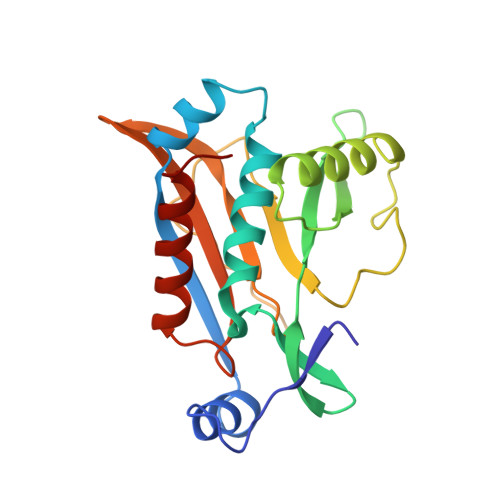Evidence for transition-state stabilization by serine-148 in the catalytic mechanism of chloramphenicol acetyltransferase.
Lewendon, A., Murray, I.A., Shaw, W.V., Gibbs, M.R., Leslie, A.G.(1990) Biochemistry 29: 2075-2080
- PubMed: 2109633
- DOI: https://doi.org/10.1021/bi00460a016
- Primary Citation of Related Structures:
1CLA - PubMed Abstract:
The function of conserved Ser-148 of chloramphenicol acetyltransferase (CAT) has been investigated by site-directed mutagenesis. Modeling studies (P. C. E. Moody and A. G. W. Leslie, unpublished results) suggested that the hydroxyl group of Ser-148 could be involved in transition-state stabilization via a hydrogen bond to the oxyanion of the putative tetrahedral intermediate. Replacement of serine by alanine results in a mutant enzyme (Ala-148 CAT) with kcat reduced 53-fold and only minor changes in Km values for chloramphenicol and acetyl-CoA. The Ser-148----Gly substitution gives rise to a mutant enzyme (Gly-148 CAT) with kcat reduced only 10-fold. A water molecule may partially replace the hydrogen-bonding potential of Ser-148 in Gly-148 CAT. The three-dimensional structure of Ala-148 CAT at 2.34-A resolution is isosteric with that of wild-type CAT with two exceptions: the absence of the Ser-148 hydroxyl group and the loss of one poorly ordered water molecule from the active site region. The results are consistent with a catalytic role for Ser-148 rather than a structural one and support the hypothesis that Ser-148 is involved in transition-state stabilization. Ser-148 has also been replaced with cysteine and asparagine; the Ser-148----Cys mutation results in a 705-fold decrease in kcat and the Ser-148----Asn substitution in a 214-fold reduction in kcat. Removing the hydrogen bond donor (Ser-148----Ala or Gly) is less deleterious than replacing Ser-148 with alternative possible hydrogen bond donors (Ser-148----Cys or Asn).
- Department of Biochemistry, University of Leicester, U.K.
Organizational Affiliation:


















